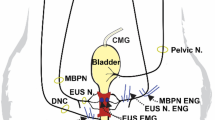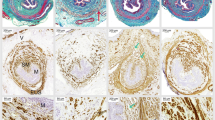Abstract
This study aims to evaluate the urethral nerve fibers of adult female rats during pregnancy and after vaginal birth, cesarean section or simulated birth trauma. For immunohistochemical analysis of nerve fibers, 70 female rats were distributed in seven groups of ten female rats: group 1, control; group 2, pregnant; group 3, cesarean section; group 4, vaginal birth; group 5, virgin female rats with simulated birth trauma; group 6, cesarean section followed by simulation of birth trauma; and group 7, vaginal birth followed by simulation of birth trauma. The number of nerve fibers in groups 1, 2, and 3 were significantly higher than the other groups. Pregnancy and cesarean section did not cause alterations in the nerve fibers number. Vaginal birth and simulated birth trauma significantly decreased the number of nerve fibers in the female rats’ middle urethra.





Similar content being viewed by others
References
Iosif S, Bekassy Z (1984) Prevalence of genito-urinary symptoms in the late menopause. Acta Obstet Gynecol Scand 63:257–260
Diokno AC, Brock BM, Brown, MB, Herzog R (1986) Prevalence of urinary incontinence and other urological symptoms in the noninstitutionalized elderly. J Urol 136:1022–1025
Wyman JF, Harkins SW, Choi SC, Taylor JR, Fantl JA (1987) Psychosocial impact of urinary incontinence in women. Obstet Gynecol 70:378–381
Sørensen SM, Bondesen H, Istre O, Vilmann P (1988) Perineal rupture following vaginal delivery. Long-term consequences. Acta Obstet Gynecol Scand 67:315–318
Rekers H, Drogendijk AC, Valkenburg H, Riphagem F (1992) Urinary incontinence in women from 35 to 79 years of age: prevalence and consequences. Eur J Obstet Gynecol Reprod Biol 43:229–234
Brown JS, Grady D, Ouslander JG, Herzog AR, Varner RE, Posner SF (1999) Prevalence of urinary incontinence and associated risk factors in postmenopausal women. Obstet Gynecol 94:66–70
Gainey HL (1955) Postpartum observation of pelvic tissue damage: further studies. Am J Obstet Gynecol 70(4):800–807
Beck RP, Hsu N (1965) Pregnancy, childbirth, and the menopause related to the development of stress incontinence. Am J Obstet Gynecol 91:820–823
Iosif S, Henriksson L, Ulmsten U (1981) Postpartum incontinence. Urol Int 36:53–58
Waltzer WC (1981) The urinary tract in pregnancy. J Urol 125:271–276
Carlile A, Davies J, Rigby A, Brocklehurst JC (1988) Age changes in the human female urethra: a morphometric study. J Urol 139:532–535
Tapp A, Cardoso L, Versi E, Montgomery J, Studd J (1988) The effect of vaginal delivery on the urethral sphincter. Br J Obstet Gynaecol 95:142–146
Skoner MM, Thompson WD, Caron VA (1994) Factors associated with risk of stress urinary incontinence in women. Nurs Res 43(5):301–306
Bent AE, McLennan MT (1996) Geriatric urogynecology. In: Ostergard DR, Bent AE (eds) Urogynecology and urodynamics: theory and practice, 4th ed. Williams & Wilkins, Baltimore, pp 441–462
Thom DH, van den Eeden SK, Brown JS (1997) Evaluation of parturition and other reproductive variables as risk factors for urinary incontinence in later life. Obstet Gynecol 90:983–989
Crist T, Shingleton HM, Koch GG (1972) Stress incontinence and the nulliparous patient. Obstet Gynecol 40(1):13–17
Mikhail MS, Anyaegbunam A (1995) Lower urinary tract dysfunction in pregnancy: a review. Obstet Gynecol Surv 50:675–683
Meyer S, Schreyer A, De Grandi P, Hohlfeld P (1998) The effects of birth on urinary continence mechanisms and other pelvic-floor characteristics. Obstet Gynecol 92:613–618
Dannecker C, Anthuber C (2000) The effects of childbirth on the pelvic-floor. J Perinat Med 28:175–184
Pregazzi R, Sartore A, Bortoli P, Grimaldi E, Ricci G, Guaschino S (2002a) Immediate postpartum perineal examination as a predictor of puerperal pelvic floor dysfunction. Obstet Gynecol 99:581–584
Pregazzi R, Sartore A, Troiano L, Grimaldi E, Bortoli P, Siracusano S, Guaschino S (2002b) Postpartum urinary symptoms: prevalence and risk factors. Eur J Obstet Gynecol Reprod Biol 103:179–182
Allen RE, Hosker GL, Smith AR, Warrell DW (1990) Pelvic floor damage and childbirth: a neurophysiological study. Br J Obstet Gynaecol 97:770–779
Snooks SJ, Swash M, Mathers SE, Henry MM (1990) Effects of vaginal delivery on the pelvic floor: a 5-year follow-up. Br J Surg 77:1358–1360
Handa VL, Harris TA, Ostergard DR (1996) Protecting the pelvic floor: obstetric management to prevent incontinence and pelvic organ prolapse. Obstet Gynecol 88:470–478
Bakircioglu ME, Sievert KD, Lau A, Lin CS, Lue TF (2000) The effect of pregnancy and delivery on the function and ultrastructure of the rat bladder and urethra. BJU Int 85:350–361
Snooks SJ, Barnes PR, Swash M (1984a) Damage to the innervation of the voluntary anal and periurethral sphincter musculature in incontinence: an electrophysiological study. J Neurol Neurosurg Psychiatry 47:1269–1273
Snooks SJ, Badenoch DF, Tiptaft RC, Swash M (1985a) Perineal nerve damage in genuine stress urinary incontinence. An electrophysiological study. Br J Urol 57:422–426
Snooks SJ, Swash M, Henry MM, Setchell M (1985b) Risk factors in childbirth causing damage to the pelvic floor innervation. Br J Surg 72(Suppl):S15–S17
Barnick CGW, Cardozo LD (1993) Denervation and re-inervation of urethral sphincter in the etiology of genuine stress incontinence: an electromyographic study. Br J Obstet Gynaecol 100:750–753
Wall LL (1993) The muscles of the pelvic floor. Clin Obstet Gynecol 36(4):910–925
Deindl FM, Voduzek DB, Hesse U, Schüssler B (1994) Pelvic floor activity patterns: comparison of nulliparous continent and parous urinary stress incontinent women. A kinesiological EMG study. Br J Urol 73:413–417
Snooks SJ, Swash M (1984) Abnormalities of the innervation of the urethral striated sphincter musculature in incontinence. Br J Urol 56:401–405
Snooks SJ, Swash M, Setchell M, Henry MM (1984b) Injury to innervation of pelvic floor sphincter musculature in childbirth. Lancet 2:546–50
Gilpin SA, Gosling JA, Smith AR, Warrell DW (1989) The pathogenesis of genitourinary prolapse and stress incontinence of urine. A histological and histochemical study. Br J Obstet Gynaecol 96:15–23
Smith AR, Hosker GL, Warrell DW (1989a) The role of partial denervation of the pelvic floor in the etiology of genitourinary prolapse and stress incontinence of urine. A neurophysiological study. Br J Obstet Gynaecol 96:24–28
Smith AR, Hosker GL, Warrell DW (1989b) The role of pudendal nerve damage in the etiology of genuine stress incontinence in women. Br J Obstet Gynaecol 96:29–32
Sultan AH, Kamm MA, Hudson CN (1994) Pudendal nerve damage during labor: prospective study before and after childbirth. Br J Obstet Gynaecol 101:22–28
Tetzschner T, Sørensen M, Lose G, Christiansen J (1997) Pudendal nerve function during pregnancy and after delivery. Int Urogynecol J 8:66–68
Lin AS, Carrier S, Morgan DM, Lue TF (1998) Effect of simulated birth trauma on the urinary continence mechanism in the rat. Urology 52(1):143–151
Sievert KD, Emre Bakircioglu M, Tsai T, Dahms SE, Nunes L, Lue TF (2001) The effect of simulated birth trauma and/or ovariectomy on rodent continence mechanism. Part 1: functional and structural change. J Urol 166:311–317
Baker DEJ (1979) Reproduction and breeding. In: Baker HJ, Lindsey JR, Weisbroth SH (eds) The laboratory rat, vol 1. Academic, New York, pp 154–168
Neter J, Wasserman W, Kutner MH (1990) Applied linear statistical models, 3rd edn. Irwin, Homewood, IL
Littell RC, Milliken GA, Stroup WW, Wolfinger RD (1996) SAS system for mixed models. SAS Institute, North Carolina
Dimpfl T, Hesse U, Schüssler B (1992) Incidence and cause of postpartum urinary stress incontinence. Eur J Obstet Gynecol Reprod Biol 43:29–33
Minaire P, Jacquetin B (1992) La prevalence de I’incontinence urinaire féminine em médicine générale. J Gynecol Obstet Biol Reprod (Paris) 21:731–738
Buchsbaum GM, Chin M, Glantz C, Guzick D (2002) Prevalence of urinary incontinence and associated risk factors in a cohort of nuns. Obstet Gynecol 100:226–229
Viktrup L, Lose G, Rolff M, Barfoed K (1992) The symptom of stress incontinence caused by pregnancy or delivery in primiparas. Obstet Gynecol 79:945–949
Wilson PD, Herbison RM, Herbison GP (1996) Obstetric practice and the prevalence of urinary incontinence three months after delivery. Br J Obstet Gynaecol 103:154–161
Author information
Authors and Affiliations
Corresponding author
Rights and permissions
About this article
Cite this article
Rocha, M.A., Sartori, M.G.F., De Jesus Simões, M. et al. Impact of pregnancy and childbirth on female rats’ urethral nerve fibers. Int Urogynecol J 18, 1453–1458 (2007). https://doi.org/10.1007/s00192-007-0355-3
Received:
Accepted:
Published:
Issue Date:
DOI: https://doi.org/10.1007/s00192-007-0355-3




